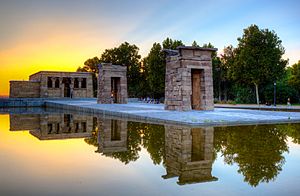Temple of Debod facts for kids
Quick facts for kids Temple of Debod |
|
|---|---|
| Native name Spanish: Templo de Debod |
|
 |
|
| Location | Madrid, Spain |
| Built | 200 BC |
| Rebuilt | 1970–1972 |
| Architectural style(s) | Ancient Egyptian |
| Official name: Templo de Debod | |
| Type | Non-movable |
| Criteria | Monument |
| Designated | 2008 |
| Reference no. | RI-51-0012074 |
The Temple of Debod (Spanish: Templo de Debod) is an ancient Egyptian temple that you can now find in Madrid, Spain. This temple was first built over 2,200 years ago in Egypt. It was located about 15 kilometers south of Aswan, a city in Egypt.
In 1968, the Egyptian government gave the temple to Spain. This was a thank-you gift for Spain's help in saving many historical sites. These sites were in danger because of a new dam being built. The temple was carefully taken apart, moved to Spain, and then put back together. It opened to the public in Madrid between 1970 and 1972. It is one of the very few ancient Egyptian buildings located outside of Egypt. It is also the only one of its kind in Spain.
Contents
The Temple's Design and Art
The Temple of Debod was originally built in a region called Nubia. This area was very close to the first big waterfall of the Nile River. It was also near a major religious center dedicated to the goddess Isis.
Around 200 BC, a king named Adikhalamani from the ancient kingdom of Meroë started building the temple. He began with a small, single room. This room was a chapel dedicated to the Egyptian god Amun. Later, during the time of the Ptolemaic dynasty (a family of Greek rulers in Egypt), the temple became larger. Kings like Ptolemy VI, Ptolemy VIII, and Ptolemy XII added to it. They made it a small temple about 12 by 15 meters in size. It was dedicated to Isis of Philae. Even later, the Roman emperors Augustus and Tiberius finished making it bigger.
The temple complex had a long pathway that led from a dock to the main temple. This path went through three stone gateways. The front part of the temple, called the pronaos, had four tall columns. This part sadly collapsed in 1868 and is now gone. Behind it was the original chapel for Amun. There was also a room for offerings and other side rooms. Stairs led up to the roof.
Moving the Temple to a New Home
In 1960, a huge dam called the Aswan High Dam was being built in Egypt. This dam would create a large lake. This lake would flood and destroy many ancient monuments and historical sites. To save these important places, UNESCO (a part of the United Nations) asked for help from countries around the world.
Spain helped a lot in saving the famous Abu Simbel temples. Because of this help, the Egyptian government gave the Temple of Debod to Spain in 1968 as a gift.
The temple was carefully taken apart, stone by stone. Each stone was numbered. Then, it was shipped to Spain and rebuilt in one of Madrid's parks. This park is called the Parque del Oeste, and it's close to the Royal Palace of Madrid. The temple opened to visitors in 1972. When it was put back together, some of the gateways were placed in a different order than they were in Egypt.
The Temple of Debod is special because it's one of the very few ancient Egyptian buildings you can see outside of Egypt. It's the only one like it in Spain. For a long time, the temple was open to the weather. In February 2020, the city council of Madrid decided to make plans to cover the monument. This will help protect it from rain and other weather, keeping it safe for many more years.
Other Temples Moved from Egypt
The Temple of Debod is one of four temples that Egypt gave to other countries. These countries helped save monuments during the building of the Aswan High Dam.
- Temple of Debod (Madrid, Spain)
- Temple of Dendur (Metropolitan Museum of Art, New York, United States)
- Temple of Taffeh (Rijksmuseum van Oudheden in Leiden, the Netherlands)
- Temple of Ellesyia (Museo Egizio, Turin, Italy)
See also
 In Spanish: Templo de Debod para niños
In Spanish: Templo de Debod para niños




